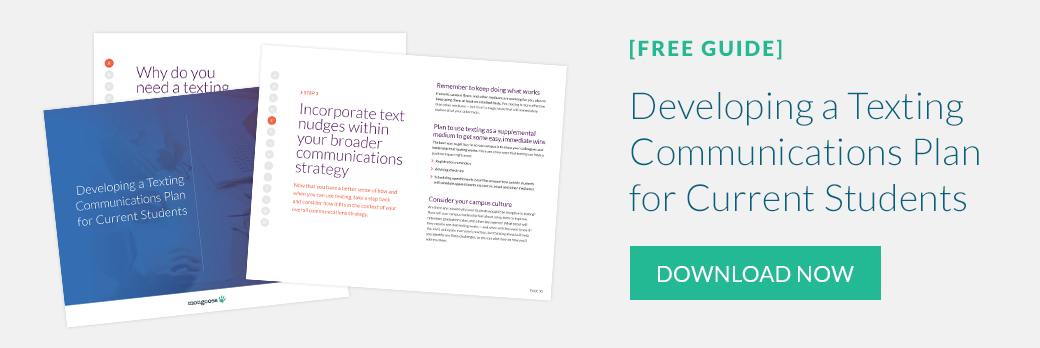We all know by now that texting is an extremely effective way to communicate with students. Campuses across the country are using texting to varying degrees with a range of success. The texting platform selected by the institution seems to be the benchmark that determines how successful the institution will be.
What is a texting platform?
It’s a way to allow staff members to send text messages directly to a student’s mobile phone with a computer, tablet, or smartphone. While a student receives the message as a normal text, the staff member gets to track conversations, integrate with their Student Information System (SIS), send messages to groups of students simultaneously, track results, and pass conversations to colleagues and department heads.
Why do you need a platform?
Because sending students texts from personal staff phones is problematic – it might be a cheap and easy solution, but your staff phones will be subject to a flood of confusing messages from unidentified numbers that could buzz your pocket at any time.
“I gave out my cell phone number in a few instances with students,” noted Jeff McNamara from Carroll University. He started to get texts from random students, asking if school was cancelled because of bad weather. “You start getting the 4 a.m. texts, ‘Do we have classes today?’ and you have no idea who they’re from.”
There are three essential outcomes to consider as you evaluate your options:
1) Efficiency.
Text ‘alerts’ are for emergency notifications. Texting, on the other hand, is all about real conversations and engagement. Staff needs to be able to quickly send messages to individual and groups of students. Likewise, when a student responds, staff needs to be able to respond in kind. We’re all given only 24 hours each day. Making staff as efficient as humanly possible is paramount. Things to look for: how easy-to-use is the texting platform? Software that is cumbersome or overly complex will not be adopted well.
2) Flexibility.
Every institution is unique. Every department is unique. In some cases individual texting accounts should be used (so the student feels they are texting directly with individual staff). In other cases, there are needs for “group accounts” or “shared inboxes”. This allows multiple staff members to manage a single texting account for communicating more general information. For example, a typical setup might be:
| Individual Account | Group Account | |
| Admissions Counselor | X | |
| Financial Aid Advisor(s) | X | |
| Student Success Coach | X | |
| Registrar | X |
These different types of accounts should be easy to set up, manage, and most importantly - use.
Think long-term. The collegiate student experience (often) begins during sophomore year of high school, transitions to their time while enrolled, and continues well past graduation. Students grow accustomed to a level of service and communication from your institution. Ensure the platform will gracefully extend across the student lifecycle, which, from an IT-perspective, also translates to the platform’s abilities to integrate with multiple information systems on campus and to mirror existing data and permission structures.
3) Reputation.
Doing your due diligence upfront will go a long way ensuring you selected the right texting platform. Every company will say they are the best fit for you. Obviously someone from Mongoose is going to assure you that Cadence is the best platform (and we agree), but don’t take our word for it. Rather, ask as many of your colleagues from other institutions, hit the listserv’s, ask around at conferences. Your colleagues at other institutions are a much better guide in what will be most likely to work for you. Selecting a partner that will provide unprecedented support and best practices is a great recipe for success.
A texting communications plan sets a direct path to reaching goals
Any texting platform can bring your institution results, but the one that best fits your overall communications strategy will bring you closer to your objectives. When you find the perfect texting solution for your school, don’t forget to adjust your communications plan accordingly.
Ready to get started? Download our free guide: Developing a Texting Communications Plan for Current Students.






.webp?width=57&height=74&name=users-love-us-4fca521cb6d80c30d02e3df6bd0013f5395fb3ae22e81b3e3608e258d8feba63%20(1).webp)